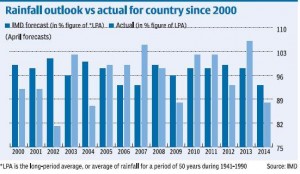First Forecasts of the Season Released for Indian Monsoon
by Walter Hsiang
With the anticipated arrival of monsoon season in Asia at the start of May, people have a right to be anxious. The annual summer monsoon is the major source of rain in India and much of South Asia, so it has a huge impact on environmental, social, and economic factors in those regions. For example, an overly strong or weak Indian summer monsoon can result in flooding or crop failures. Therefore, accurate monsoon predictions are important for everyone from farmers to politicians so that they may prepare accordingly.

India has an age-old relationship with the monsoon, and very few climate-related events around the globe can compare with the monsoon’s scale and its impact on the economy. The monsoon is estimated to influence 15% of India’s GDP, and the agriculture and energy sectors are most heavily affected. But beyond the economy, the monsoon greatly affects the livelihood of people who live in rural India. These people don’t have access to robust infrastructure and depend on farming for sustenance.
Because the monsoon season bears so much weight, the release of the India Meteorological Department’s long-range forecast (released this past week) has become an annual financial and political event. Private forecasting companies like Skymet have tried to capitalize on this anticipation by releasing their own forecast reports ahead of time.
This year, Skymet has predicted normal monsoon rainfall (102% of the long-term average), while the India Meteorological Department has forecast below-normal rainfall (only 93% of the long-term average). Skymet’s forecast had brought hope to the region, particularly after last year’s deficit monsoon which brought very little rainfall. But if the Meteorological Department is right, the region is in for another dry year — although their forecast of 93% of normal rainfall may not seem that bad, widespread drought characterized the 2012 monsoon which had a total rainfall very near that exact value. And it is good to remember that rainfall can vary regionally within India and temporally throughout the year; unseasonal rains this past February damaged over 27 million acres of farmland in six regions of India.

The Indian economy is really a gamble on the monsoon. Seventy percent of India’s annual rainfall, which irrigates the country’s farmland, comes from the monsoon. The associated weather patterns affect productivity, industrial and agricultural output, health, and energy consumption. When monsoon season does not strike the delicate balance between not-too-much and not-too-little rainfall, it can increase food prices and reduce energy output, which worsens inflation.
Yet India’s reliance in recent years on the monsoon forecasting by the India Meteorological Department (IMD) has also been a gamble. Between 1988 and 2002, the IMD used a 16-parameter statistical prediction model that was claimed to be successful until it crumbled in a 2002 drought. Monsoons have been less predictable since then. The IMD has been working hard on new models that combine statistical and dynamic forecasts, but the average prediction error has only come down by 2% in the last decade. Just last year, the IMD’s prediction of monsoon rainfall was off by nearly 10%. The current forecasts use both a 5-parameter statistical model and an experimental atmosphere-ocean dynamical model.
Despite Skymet’s and IMD’s monsoon prognosis, huge uncertainty remains. It calls into question India’s continued reliance on the monsoon rains, especially with the country’s fast development and modernization. Above all, it outlines a need to develop solutions that reduce India’s vulnerability to unexpected changes in the monsoon.
First Forecasts of the Season Released for Indian Monsoon
by Walter Hsiang
With the anticipated arrival of monsoon season in Asia at the start of May, people have a right to be anxious. The annual summer monsoon is the major source of rain in India and much of South Asia, so it has a huge impact on environmental, social, and economic factors in those regions. For example, an overly strong or weak Indian summer monsoon can result in flooding or crop failures. Therefore, accurate monsoon predictions are important for everyone from farmers to politicians so that they may prepare accordingly.

India has an age-old relationship with the monsoon, and very few climate-related events around the globe can compare with the monsoon’s scale and its impact on the economy. The monsoon is estimated to influence 15% of India’s GDP, and the agriculture and energy sectors are most heavily affected. But beyond the economy, the monsoon greatly affects the livelihood of people who live in rural India. These people don’t have access to robust infrastructure and depend on farming for sustenance.
Because the monsoon season bears so much weight, the release of the India Meteorological Department’s long-range forecast (released this past week) has become an annual financial and political event. Private forecasting companies like Skymet have tried to capitalize on this anticipation by releasing their own forecast reports ahead of time.
This year, Skymet has predicted normal monsoon rainfall (102% of the long-term average), while the India Meteorological Department has forecast below-normal rainfall (only 93% of the long-term average). Skymet’s forecast had brought hope to the region, particularly after last year’s deficit monsoon which brought very little rainfall. But if the Meteorological Department is right, the region is in for another dry year — although their forecast of 93% of normal rainfall may not seem that bad, widespread drought characterized the 2012 monsoon which had a total rainfall very near that exact value. And it is good to remember that rainfall can vary regionally within India and temporally throughout the year; unseasonal rains this past February damaged over 27 million acres of farmland in six regions of India.

The Indian economy is really a gamble on the monsoon. Seventy percent of India’s annual rainfall, which irrigates the country’s farmland, comes from the monsoon. The associated weather patterns affect productivity, industrial and agricultural output, health, and energy consumption. When monsoon season does not strike the delicate balance between not-too-much and not-too-little rainfall, it can increase food prices and reduce energy output, which worsens inflation.
Yet India’s reliance in recent years on the monsoon forecasting by the India Meteorological Department (IMD) has also been a gamble. Between 1988 and 2002, the IMD used a 16-parameter statistical prediction model that was claimed to be successful until it crumbled in a 2002 drought. Monsoons have been less predictable since then. The IMD has been working hard on new models that combine statistical and dynamic forecasts, but the average prediction error has only come down by 2% in the last decade. Just last year, the IMD’s prediction of monsoon rainfall was off by nearly 10%. The current forecasts use both a 5-parameter statistical model and an experimental atmosphere-ocean dynamical model.
Despite Skymet’s and IMD’s monsoon prognosis, huge uncertainty remains. It calls into question India’s continued reliance on the monsoon rains, especially with the country’s fast development and modernization. Above all, it outlines a need to develop solutions that reduce India’s vulnerability to unexpected changes in the monsoon.